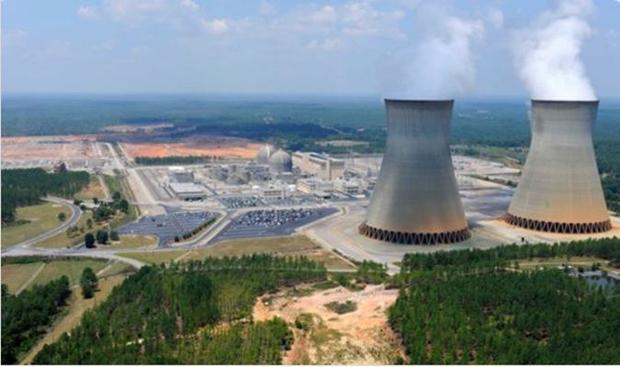If built, the reactors are expected to cost as much as $21.8 billion and wouldn’t be ready until at least 2031, according to the Palm Beach Post.
The proposed 2,200-megawatt Turkey Point 6 and 7 reactors would be built at the same facility where FPL already has two operating reactors overlooking Biscayne Bay, about 30 miles south of Miami. FPL spokesman Peter Robbins said they should have the licenses by the end of the month.
“It has been nine years. We are very pleased,” Robbins said. “We felt this was an important thing for our customers all along. It gives us an option. When we started this process. We saw a need in terms of growth, and it provides fuel diversity. It is very important for us to have diverse sources of fuel. Nuclear is very stable in terms of fuel prices. It is very reliable and emissions-free.”
Spiraling construction costs and delays plague new nuclear plants
Robbins did say that FLP will be monitoring the construction of Plant Vogtle in southern Georgia, the only nuclear power plant construction project going on in North America. Vogtle is expected to be completed in about four years. “We are not going to be making a decision until that project is done,” Robbins said.
But Robbins failed to mention that the Department of Energy had to shell out $3.7 billion in loan guarantees to Georgia Power and its subsidiaries in October 2017. And that money was in addition to the previous loan guarantees given out by the DOE that included $6.5 billion to Georgia Power and Oglethorpe Power in 2014 and an additional support of $1.8 billion in 2015, according to Digital Journal.
As a result of the infusion of cash, Georgia Power and its partner utilities are moving forward with completion of its twin AP1000s, despite billions in cost overruns and other problems.
The FLP Application has a lot of departures from accepted rules
Florida Trends reports the NRC authorized its Office of New Reactors to grant the licenses to FLP after a hearing Dec. 12, 2017. NRC found their staff’s review of the FLP application was “adequate to make the necessary regulatory safety and environmental findings.”
I guess it is now time to point out the FLP application was submitted back in 2009. In 2016, the NRC’s Advisory Committee on Reactor Safeguards did an independent review of the application’s safety aspects and the staff’s final safety report. And finally, the NRC did an environmental review that was completed in October 2016.
The safety and environmental evaluation reports are available online and they will require a lot of reading and multiple cups of coffee, but one thing is quite obvious — The observations and conclusions the NRC came to do not reflect the current environmental and safety concerns present in today’s climate.
Let’s talk about just a couple of items I found interesting. First, the two emergency planning zones around nuclear power plants, set in 2006, designates a plume exposure pathway zone with a radius of 10 miles (16 km), concerned primarily with exposure to, and inhalation of, airborne radioactive contamination, and an ingestion pathway zone of about 50 miles (80 km), concerned primarily with ingestion of food and liquid contaminated by radioactivity.
In 2010, the population within 10 miles (16 km) of Turkey Point was 161,556, an increase of 62.8 percent in a decade. During the same time period, the population within 50 miles (80 km) was 3,476,981, an increase of 15.1 percent since 2000. Miami is within the 50-mile radius.
In the FLP application submitted in 2009, FLP asked for and received an exemption on exclusion zones for the new reactors, based on outdated sea level, air temperature and climate data.
What about sea level rise? In 2014, an investigation by weather.com and the Huffington Post identified the Turkey Point plant as one of the eight U.S. power plants most vulnerable to flooding from sea level rise by the end of the century. This assessment was based on current projections of expected sea level rise.
FLP’s application was based on historical data and they came to the conclusion there would be a one-foot rise in sea level over the course of the new plants’ 60 year lifetime. Turkey Point sits on an island in Biscayne Bay. The facility has similar vulnerable backup systems to prevent a meltdown as those of Japan’s Fukushima plant. The biggest difference is that Turkey Point’s reactors are sitting 20 feet above sea level.
“We are the most vulnerable metropolitan area in the world when it comes to sea level rise,” University of Miami professor Harold Wanless told the Miami New Times in 2011, reports Weather.com.
The Turkey Point nuclear power plant facility does not use a cooling tower but instead has a five-by-two mile (20-square-mile (52 km2)) network of canals covering nearly 6,000 acres. The canals have caused a number of problems, including pollution of Florida’s nearby national parks or the water supply, particularly the Biscayne Aquifer where public drinking water comes from.
Then there are the overheating and radioactive materials issues. Twice in 2014, overheating in the canals caused the reactors to shut down. In 2016, during a cleanup project that included injecting hypersaline water deep into the boulder zone beneath the aquifer in order to make the canals more shallow, something went wrong and now saltwater contamination reaches at least four miles to the west of the plant.
What is astounding to me is that no up-to-date environmental assessment was done that takes into account climate change, the uptick in the number of Category 3 and above Atlantic hurricanes or a warming climate. So yes, this was the dumb move of the week.

















